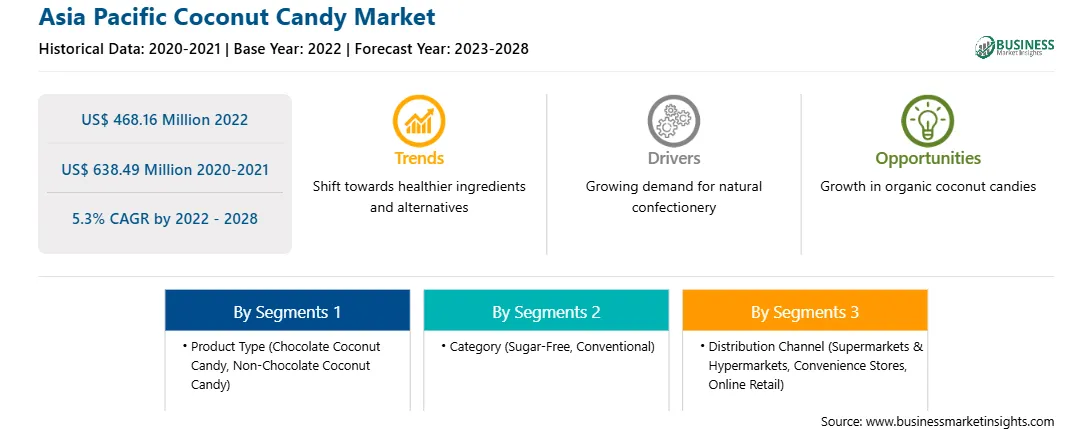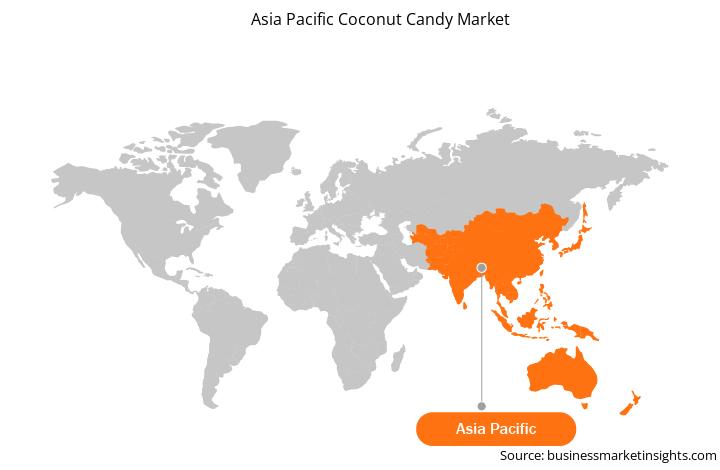The coconut candy market in Asia Pacific is expected to grow from US$ 468.16 million in 2022 to US$ 638.49 million by 2028. It is estimated to grow at a CAGR of 5.3% from 2022 to 2028.
Consumer Inclination Toward Vegan Candies
Veganism is gaining significant traction with consumers becoming increasingly concerned about animal cruelty, sustainability, and health and well-being. Registrations for “Veganuary,” a nonprofit organization that encourages people to eat vegan food in January, are increasing at a dramatic rate, with 620,000 registrations in 2022. According to Veganuary, the veganism trend is becoming more than just a one-month commitment as a large number of people are permanently shifting toward plant-based food. The increasing preference for vegan food is mainly attributed to the perceived health benefits of plant-based food over animal-derived food. Moreover, the rising number of affiliations for animal safety is also favoring the vegan industry’s growth. Vegan candies, constituting 100% plant-based ingredients, are highly suitable for consumers looking for healthy indulgence. Coconut candies are also expected to gain huge traction among consumers with a rising inclination toward vegan candies. Confectionery manufacturers are launching coconut candies with vegan claims to appeal to a large number of consumers. For example, in January 2021, Bounty, a brand of Mars Incorporated, launched vegan chocolate bars blended with diced coconut, inspired by tropical flavors. The product is 100% vegan and gluten free. Thus, the rising preference for vegan candies is likely to emerge as a new trend in the Asia Pacific coconut candy market during the forecast period.
Market Overview
Australia, China, India, Japan, South Korea, and the Rest of Asia Pacific are the key contributors to the coconut candy market in the Asia Pacific. Asia Pacific significantly contributes to the production and consumption of coconut-based products as the major plantations are found in countries such as Indonesia, the Philippines, India, Sri Lanka, and Vietnam. According to an article published by the Food and Agriculture Organization of the United Nations, the 15 member countries of the Asian and Pacific Coconut Community (APCC) account for a major share of area and production, occupying 10.7 million ha (87%) and 9.2 million MT of copra equivalent (82.81%). Indonesia, the Philippines, and India are the major producers of coconut in the world. Thus, it is convenient for manufacturers to procure raw materials for making coconut-based confectioneries such as coconut candy. These factors are anticipated to drive market growth in the region. Moreover, Vietnam is one of the well-established markets for coconut candies—Kẹo dừa—a Vietnamese coconut candy produced in Bến Tre province, Vietnam. This candy is made with coconut milk and coconut cream. Additionally, there are over a hundred coconut candy manufacturers in Bến Tre (Vietnam), making up 30% of local enterprises. However, the market is dominated by a handful of well-known brands, with most manufacturers producing candy under license for these brands. These candies are also exported to other Asian countries, such as Australia. Manufacturers offer a wider range of products in accordance with consumer needs—such as non-GMO, sugar-free, clean-label products—as consumers in the region are getting health conscious, resulting in the increasing demand for low-calorie and sugar-free confectionery products. Consumers in the region have diversified tastes and preferences and are fond of experimenting with new flavors. These factors are expected to drive the growth of the Asia Pacific coconut candy market in the region.

Strategic insights for the Asia Pacific Coconut Candy provides data-driven analysis of the industry landscape, including current trends, key players, and regional nuances. These insights offer actionable recommendations, enabling readers to differentiate themselves from competitors by identifying untapped segments or developing unique value propositions. Leveraging data analytics, these insights help industry players anticipate the market shifts, whether investors, manufacturers, or other stakeholders. A future-oriented perspective is essential, helping stakeholders anticipate market shifts and position themselves for long-term success in this dynamic region. Ultimately, effective strategic insights empower readers to make informed decisions that drive profitability and achieve their business objectives within the market.

| Report Attribute | Details |
|---|---|
| Market size in 2022 | US$ 468.16 Million |
| Market Size by 2028 | US$ 638.49 Million |
| Global CAGR (2022 - 2028) | 5.3% |
| Historical Data | 2020-2021 |
| Forecast period | 2023-2028 |
| Segments Covered |
By Product Type
|
| Regions and Countries Covered | Asia-Pacific
|
| Market leaders and key company profiles |
The geographic scope of the Asia Pacific Coconut Candy refers to the specific areas in which a business operates and competes. Understanding local distinctions, such as diverse consumer preferences (e.g., demand for specific plug types or battery backup durations), varying economic conditions, and regulatory environments, is crucial for tailoring strategies to specific markets. Businesses can expand their reach by identifying underserved areas or adapting their offerings to meet local demands. A clear market focus allows for more effective resource allocation, targeted marketing campaigns, and better positioning against local competitors, ultimately driving growth in those targeted areas.

Asia Pacific Coconut Candy Market Segmentation
The Asia Pacific coconut candy market is segmented into product type, category, distribution channel, and country.
Based on product type, the market is bifurcated into chocolate coconut candy and non-chocolate coconut candy. The chocolate coconut candy segment registered the larger market share in 2022.
Based on category, the market is bifurcated into sugar-free and conventional. The conventional segment held a larger market share in 2022.
Based on distribution channel, the market is segmented into supermarkets & hypermarkets, convenience stores, online retail, and others. The supermarkets & hypermarkets segment held the largest market share in 2022.
Based on country, the market is segmented into Australia, China, India, Japan, South Korea, and the Rest of Asia Pacific. China dominated the market share in 2022.
Alfred Ritter GmbH & Co. KG; Chocoladefabriken Lindt and Spruengli AG; Ferrero International S.A.; Godiva; Mars Incorporated; The Hershey Company; Unreal Brands Inc.; and Weetabix Food Co. are the leading companies operating in the coconut candy market in the Asia Pacific region.
The Asia Pacific Coconut Candy Market is valued at US$ 468.16 Million in 2022, it is projected to reach US$ 638.49 Million by 2028.
As per our report Asia Pacific Coconut Candy Market, the market size is valued at US$ 468.16 Million in 2022, projecting it to reach US$ 638.49 Million by 2028. This translates to a CAGR of approximately 5.3% during the forecast period.
The Asia Pacific Coconut Candy Market report typically cover these key segments-
The historic period, base year, and forecast period can vary slightly depending on the specific market research report. However, for the Asia Pacific Coconut Candy Market report:
The Asia Pacific Coconut Candy Market is populated by several key players, each contributing to its growth and innovation. Some of the major players include:
The Asia Pacific Coconut Candy Market report is valuable for diverse stakeholders, including:
Essentially, anyone involved in or considering involvement in the Asia Pacific Coconut Candy Market value chain can benefit from the information contained in a comprehensive market report.